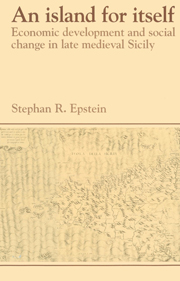Book contents
- Frontmatter
- Contents
- List of maps
- List of tables
- Acknowledgments
- Abbreviations
- Currency and measurements
- Chronology
- 1 Introduction. The historiography and the sources
- 2 Regional geographic and demographic differentiation
- 3 Market structures and regional specialization
- 4 Sicily and its regions. Economic growth and specialization
- 5 Sicily and its regions. Eastern val Demone and the southern mainland
- 6 Foreign trade and the domestic economy
- 7 Income distribution, social conflict and the Sicilian state
- 8 A further question: the origins of Sicilian underdevelopment
- Bibliography
- Index
- Past and Present Publications
2 - Regional geographic and demographic differentiation
Published online by Cambridge University Press: 06 January 2010
- Frontmatter
- Contents
- List of maps
- List of tables
- Acknowledgments
- Abbreviations
- Currency and measurements
- Chronology
- 1 Introduction. The historiography and the sources
- 2 Regional geographic and demographic differentiation
- 3 Market structures and regional specialization
- 4 Sicily and its regions. Economic growth and specialization
- 5 Sicily and its regions. Eastern val Demone and the southern mainland
- 6 Foreign trade and the domestic economy
- 7 Income distribution, social conflict and the Sicilian state
- 8 A further question: the origins of Sicilian underdevelopment
- Bibliography
- Index
- Past and Present Publications
Summary
A basic feature of the Italian countryside is its extreme regional and local geographic variation. This diversity is not restricted to central and northern Italy. Sardinia, Lazio, Calabria or Abruzzi, for example, have little in common except their (differently structured) current economic misfortunes; and the same can be said of Sicily.
Although the question of late medieval regional differentiation and specialization is developed more fully in chapter 3, two elements of this hypothesis must be briefly anticipated here. In the first place, I argue that a major consequence for western Europe of the late medieval demographic and social crisis was that comparative advantages in available natural and human resources became increasingly effective, and that, possibly for the first time in the Middle Ages, regional commercial integration became a very powerful engine of economic growth. Secondly, I take the demographic growth rate as a rough index of economic expansion in the long run, on the assumption that any given society has a certain relationship between population and resources (mediated by its institutions), and that when resources increase, so too, after a certain time-lag, does population.
- Type
- Chapter
- Information
- An Island for ItselfEconomic Development and Social Change in Late Medieval Sicily, pp. 25 - 74Publisher: Cambridge University PressPrint publication year: 1992



